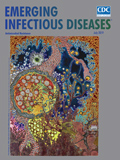
Volume 25, Number 7—July 2019
Etymologia
Etymologia: Carbapenem
On This Page
Figures
Downloads
Article Metrics
[[AA:F1:PREVIEWHTML]]
A class of broad-spectrum β-lactam antibiotics, structurally similar to penicillins, with the substitution of a carbon atom (carba-) for a sulfur atom (Figure). This substitution creates a double bond on the pentane ring, which becomes a pentene ring (-penem).
The first carbapenem, thienamycin (theion [“sulfur”] + enamine [an unsaturated compound that forms the backbone of the molecule] + -mycin [suffix for drugs produced by Streptomyces spp.]), was discovered in 1976 in culture broths of the newly recognized species Streptomyces cattleya. Thienamycin rapidly decomposes in the presence of water, which limits its clinical utility.
The first carbapenem approved for use in the United States was imipenem, the stable N-formimidoyl derivative of thienamycin, in 1985. Resistance to imipenem, encoded on a mobile genetic element, was first identified in Pseudomonas aeruginosa in Japan in 1991, and carbapenemase-producing organisms have since spread globally.
References
Figure
Cite This ArticleOriginal Publication Date: 5/14/2019






















.png)











No hay comentarios:
Publicar un comentario